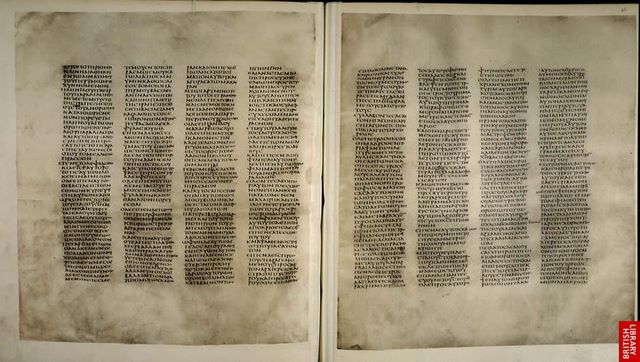Codex Sinaiticus, 350 CE
Codex Sinaiticus
St Luke’s Gospel, ‘Codex Sinaiticus’, c.350
Despite its rather austere appearance, the Codex Sinaiticus is a treasure beyond price. Produced in the middle of the fourth century, the Codex is one of the two earliest Christian Bibles. (The other is the Codex Vaticanus in Rome.) Within its beautifully handwritten Greek text are the earliest surviving copy of the complete New Testament and the earliest and best copies of some of the Jewish scriptures, in the form that they were adopted by the Christian Church. As one of the earliest luxury codices to survive in large part, the Codex forms one of the most important landmarks in the history of the book.
landmarks in the history of the book.
The literal meaning of ‘Codex Sinaiticus’ is the Sinai Book. The word ‘Sinaiticus’ derives from the fact that the Codex was preserved for many centuries at St Catherine’s Monastery near the foot of Mount Sinai in Egypt.
The Codex is the remains of a huge hand-written book that contained all the Christian scriptures of the Old and New Testaments, together with two late first-century Christian texts, the Shepherd of Hermas and the Epistle of Barnabas. This book was made up of over 1,460 pages, each of which measured approximately 41cm tall and 36cm wide.
Just over half of the original book has survived, now dispersed between four institutions- St Catherine’s Monastery, the British Library, Leipzig University Library (Germany), and the National Library of Russia in St Petersburg. At the British Library the largest surviving portion – 347 leaves, or 694 pages – includes the whole of the New Testament.
All the texts written down in the Codex are in Greek. They include the translation of the Old Testament known as the Septuagint. The Greek text is written using a form of capital or upper case letters known as Biblical majuscule and without word division. The pages of the Codex are of prepared animal skin called parchment. Shown here is part of the Gospel of Luke, containing 22-20-23-14.
Modern scholars have identified three scribes as responsible for writing the Greek text. Trained to write in very similar ways they, and their contributions to the manuscript, have been distinguished only after painstaking analysis of their handwriting, spelling and method of marking the end of each of the books of the Bible.
As is the case with most manuscripts of this antiquity, we do not know either the names of these scribes or the exact place in which they worked. Successive critics have argued that it was made in one of the great cities of the Greco-Roman world, such as Alexandria, Constantinople, or Caesarea in Palestine.
During the production of the Codex each of the scribes corrected their own work and one of them corrected and rewrote parts by another. These corrections contain many significant alterations and, together with further extensive corrections undertaken probably in the seventh century, are some of the most interesting features of the manuscript.
The Codex is critical to our understanding of the history of the Christian Bible and the development of Christianity. It is one of the two earliest surviving manuscripts into which the full ‘canon’ (collection of accepted texts) of the Christian Bible was copied into one volume. It is thus the antecedent of modern Christian Bibles. Before this date the individual books of the Bible were copied into much smaller volumes, often comprising only one or a handful of texts. The ambition of the Codex to include the entire canon of Christian scriptures coincides with the adoption of Christianity by Emperor Constantine the Great and an attempt to define once and for all, or ‘codify’, the texts that qualified as sacred scripture.
The Codex also marks a pivotal point in the history of the book. It is arguably the first large bound book to have been produced. For one volume to contain all the Christian scriptures book technology had to make a great technological leap forward. This advance was something akin to the introduction of printing with movable type or the introduction of personal computers. Whereas most previous bound books, as opposed to rolls, were relatively short and small in page size, the Codex was huge in length and large in page size.
in the history of the book. It is arguably the first large bound book to have been produced. For one volume to contain all the Christian scriptures book technology had to make a great technological leap forward. This advance was something akin to the introduction of printing with movable type or the introduction of personal computers. Whereas most previous bound books, as opposed to rolls, were relatively short and small in page size, the Codex was huge in length and large in page size.
The 694 pages held by the British Library were purchased for the British nation in 1933. Over half of the price paid, £100,000, was raised by means of a public fund-raising campaign. The seller, the Soviet government of Joseph Stalin, sold the Codex to obtain desperately needed foreign capital.
There is a project currently underway to reassemble the book’s four sections ; not physically, but in a digital version available to scholars and public all over the world.
; not physically, but in a digital version available to scholars and public all over the world.
British Library- Codex Sinaiticus
See also-




